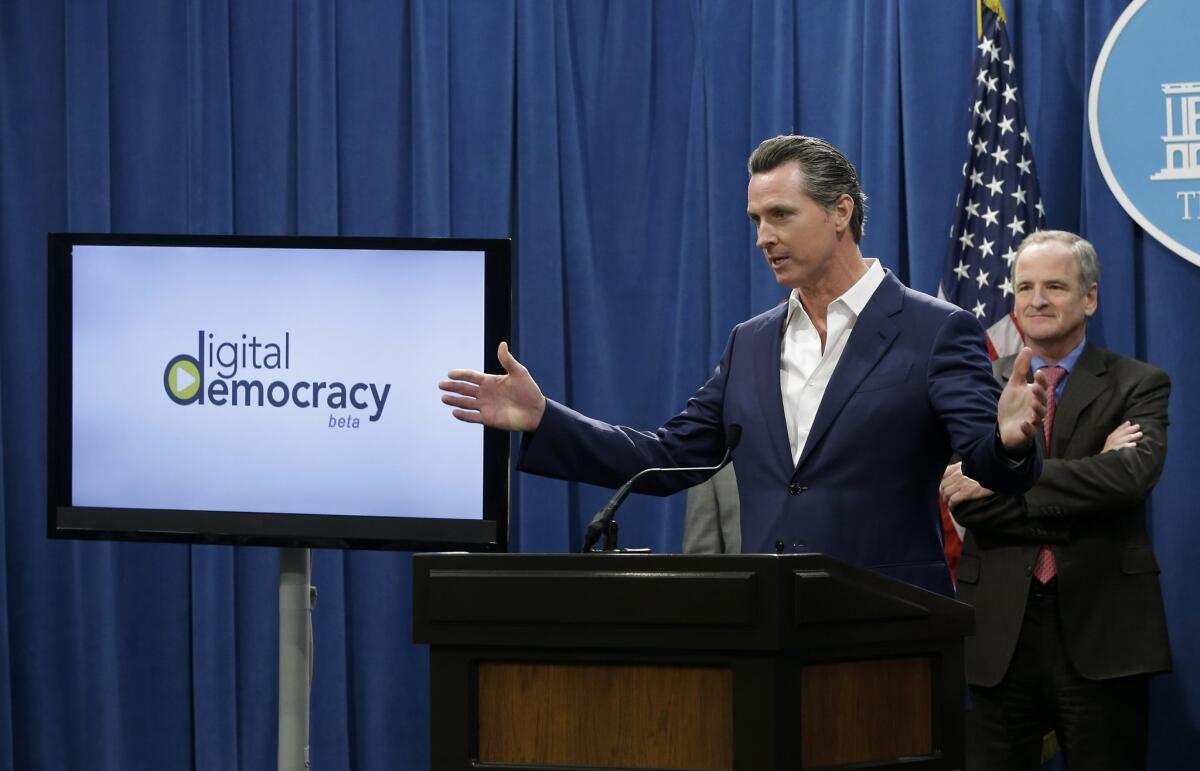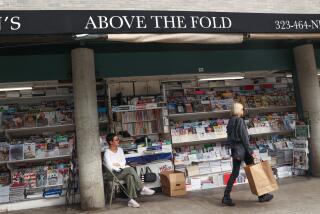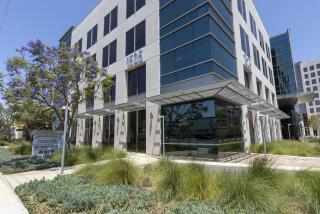Editorial: Bringing California’s government up to speed on digital technology

Lt. Gov. Gavin Newsom discusses a new video search engine that allows the public to to track legislative hearings during a news conference in Sacramento on May 6.
State governments don’t tend to be incubators of innovation. Certainly not when it comes to technology, design or digital fabulousness. That would be OK — if they recognized and adopted good ideas when they found them.
For the most part, however, they don’t. With some exceptions, the typical government website is about a decade behind the technology curve, difficult to navigate and about as effective at promoting transparency as a brick wall. California has done particularly badly on that front, according to a recent study by the California Public Interest Research Group Education Fund, which rated it one of the least digitally transparent states when it came to spending. Even Texas does a better job of making government information available online, the study found.
This is particularly embarrassing for the state that gave the world Silicon Valley, but it doesn’t have to be that way for long. A new online initiative, DigitalDemocracy.org, shows Californians exactly what they are missing and provides a blueprint for how to build it.
This civic engagement project was developed by the nonpartisan Institute for Advanced Technology and Public Policy at Cal Poly San Luis Obispo, headed by former state Sen. Sam Blakeslee. Lt. Gov. Gavin Newsom, a proselytizer for using digital tools to reconnect government with its citizens, is on the board and an enthusiastic supporter.
A beta version of the site was released this month, and even in an unfinished state it’s light years ahead of the state’s online offerings. (DigitalDemocracy.org will continue to add digital tools — such as facial recognition and Google alerts — and more data through July.)
None of the tools used by Digitaldemocracy.org is especially new, and most of the data it collects can be found on various government and government-adjacent websites, such as the secretary of state’s campaign finance interface and CalChannel, which streams legislative hearings and news conferences. What it does is arrange the information in exceedingly useful ways, and give users the ability to share video via social media. Try that with www.legislature.ca.gov.
There’s a Google-like search function that works the way people expect searches to work. Type in the name of a legislator, for example, and up pop links to videos of hearings at which he or she spoke and to a page that crunches a number of useful data collections, such as the legislator’s bills, campaign donations and gifts. It’s especially useful to find out which power brokers — law enforcement, labor unions, tobacco lobbyists — are in whose corner.
One doesn’t have to know the names of legislators or bill numbers. Users can simply type in a keyword such as “vaccination” and find listings for hearings in which that word was spoken, with video clips of that part of the hearing. There are even transcripts of the hearings, which are not found on the official legislative sites.
In a word, it’s great. Not just for wonks but for anyone who wants to find out what his or her elected state representatives are spending their time doing or the status of legislation that will affect their lives. It seems it would be especially helpful to grass-roots groups without lobbying budgets, allowing them to keep an eye on their particular issues.
Don’t take our word for it; see for yourself. So far, the searchable data only include bills for the 2015 session and campaign donations back to the 2013-14 session. That will change as the databanks grow, according to the founders. If, that is, DigitalDemocracy.org becomes a permanent fixture.
The site was built by Cal Poly students with one-time grants totaling about $1.2 million from the Laura and John Arnold Foundation and the Rita Allen Foundation. The money runs out in September, however, and DigitalDemocracy.org may end up as just a showpiece unless it finds longer-term private funders. Blakeslee said the goal was never to hand the site over to state government to run, but to build a self-sustaining model that can be used in this and other states.
That’s a fine goal, albeit a seemingly quixotic one. In the meantime, state officials should compare their own sites with the Cal Poly students’ work and learn some lessons about civic engagement.
Follow the Opinion section on Twitter @latimesopinion and Facebook
More to Read
A cure for the common opinion
Get thought-provoking perspectives with our weekly newsletter.
You may occasionally receive promotional content from the Los Angeles Times.










